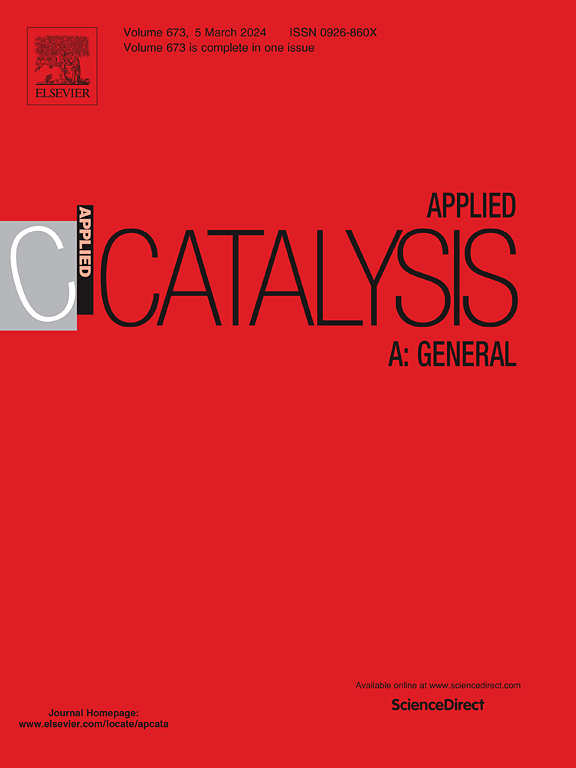CuZnAl包埋硅铝酸盐催化剂促进二氧化碳加氢制二甲醚
IF 4.8
2区 化学
Q2 CHEMISTRY, PHYSICAL
引用次数: 0
摘要
二氧化碳的资源化利用是实现减排和建立人工碳循环的可行方法。本研究主要集中在二氧化碳加氢直接合成二甲醚(DME)。采用改进的Stöber法制备了金属氧化物嵌入非晶硅铝的双功能催化剂。通过精确调节合成前驱体溶液中Si/Al摩尔比和CTAB/Si摩尔比,可以有效调节催化剂的结构特性和酸性。结果表明,与Cu/ZnO/Al2O3催化剂相比,该催化剂显著提高了二甲醚和甲醇(MeOH)的选择性,降低了CO的选择性,CO2转化率适中。硅铝比为8时,二甲醚的选择性最高,为37.94 %,甲醇和二甲醚的总选择性达到52.96 %。十六烷基三甲基溴化铵(CTAB)的加入增加了Brønsted酸位和中强酸位的比例,从而增强了甲醇脱水,抑制了水气倒转反应。当CTAB/Si摩尔比为0.1时,二甲醚的最佳选择性为43 %。本研究为CO2加氢双功能催化剂的结构设计提供了新的思路。本文章由计算机程序翻译,如有差异,请以英文原文为准。
CuZnAl embedded silicoaluminate catalyst promotion for the hydrogenation of carbon dioxide to dimethyl ether
The resource utilization of CO2 serves as a feasible method for emission reduction and the establishment of an artificial carbon cycle. This study primarily focuses on the direct synthesis of dimethyl ether (DME) from the hydrogenation of CO2. We have prepared bifunctional catalysts with metal oxides embedded in amorphous silicon-aluminum by an improved Stöber method. By precisely adjusting the Si/Al molar ratio and the CTAB/Si molar ratio in the synthesis precursor solution, structural characteristics and acid properties of the catalyst could be effectively regulated. The results indicated that compared to Cu/ZnO/Al2O3, the catalyst significantly enhanced the selectivity of DME and methanol (MeOH), reduced the selectivity of CO with a moderate conversion rate of CO2. The highest DME selectivity of 37.94 % was achieved at an Si/Al ratio of 8, with the total selectivity for methanol and DME reaching 52.96 %. The addition of cetyltrimethylammonium bromide (CTAB) increased the proportion of Brønsted acid sites and medium-strong acid sites, thereby enhancing methanol dehydration and suppressing the reverse water-gas shift reaction. The optimal selectivity for DME of 43 % was obtained over catalyst prepared with a CTAB/Si molar ratio of 0.1. This study provides a new strategy for the structural design of bifunctional catalysts for CO2 hydrogenation.
求助全文
通过发布文献求助,成功后即可免费获取论文全文。
去求助
来源期刊

Applied Catalysis A: General
化学-环境科学
CiteScore
9.00
自引率
5.50%
发文量
415
审稿时长
24 days
期刊介绍:
Applied Catalysis A: General publishes original papers on all aspects of catalysis of basic and practical interest to chemical scientists in both industrial and academic fields, with an emphasis onnew understanding of catalysts and catalytic reactions, new catalytic materials, new techniques, and new processes, especially those that have potential practical implications.
Papers that report results of a thorough study or optimization of systems or processes that are well understood, widely studied, or minor variations of known ones are discouraged. Authors should include statements in a separate section "Justification for Publication" of how the manuscript fits the scope of the journal in the cover letter to the editors. Submissions without such justification will be rejected without review.
 求助内容:
求助内容: 应助结果提醒方式:
应助结果提醒方式:


